Science, Religion, and Policy – Learning from Previous Pandemics
History shows how scientists, policymakers, and community leaders can come together to prevent the next pandemic.
- ArticlePost-truth pandemic
- November 21, 2022

The last couple of years saw unrelenting discussions on the Covid-19 pandemic and vaccination, and there were varying, often conflicting, opinions. People did not know whom to trust or where to ask questions. Hesitancy in getting vaccinated is mostly tied to mistrust in the efficacy of the vaccine due to contradictory information and lack of quality data from authorities.
The Covid crisis has highlighted the need for a more open and transparent health system and its communication, as well as better cooperation between science, the public sector, private citizens, and important institutions such as religious ones. Citizens want more consistency and honesty, and concrete, clear communication that goes beyond counting the ill and dead. Leading scientists, policymakers, and religious/social leaders need to ensure that important and accurate information is reaching the people. Unfortunately, their efforts are still not widely heard. What does history tell us about the roles of science, politics, and religion in pandemics and what can we learn from this information?
In an overtly West-centered world, the Covid-19 pandemic has been perceived as the greatest health threat humanity has faced. This has no scientific basis. Many historical epidemics and pandemics of the twentieth century were deadlier than Covid-19. As of November 2021, Covid-19 is the fourth deadliest pandemic in the last 150 years, according to the Washington-based Institute for Health Metrics and Evaluation. Some of the deadliest pandemics were the Spanish flu (17–100 million deaths), HIV/AIDS (36.3 million deaths), and the plague (12–15 million deaths). The comfort afforded by the advanced health systems in the West has led people to forget that the rest of the world still faces many outbreaks of deadly diseases. It seems that governments may look toward Asia and Africa – continents that have witnessed many such situations – for ways to deal with pandemics. This shows the importance of state decisions in current and past pandemics. The authors of a 2020 paper state, “The strong state is back, but there is no way to predict which political agenda, left or right, or which type of leader this development will support in the end.”
Scientific shortcomings and political mistakes in the time of the Spanish Flu
History shows how important it is to have a strong nexus of scientific research and political decision-making, with both positive and negative examples. Governments often say “they follow science” in their decision making, but as Alex Stevens from the University of Kent reminds us, it is often after mistakes have been made. For instance, according to science journalist Laura Spinney, at the beginning of the Spanish flu, health experts did not see a need for quarantines, and due to the ongoing World War I, the governments hid the extent of fatalities so as to not show weakness in the final stages of the war. Spinney argues that influenza was not considered something worth alerting the public health authorities about and a delayed response ensued. Making mistakes is part of any science research. In fact, mistakes are encouraged to help secure better answers, assures Spinney. During the Spanish flu pandemic, scientists were unsure what steps were to be taken and only with the second wave in the second half of August 1918 did first measures arrive in the form of maritime quarantines on islands, social distancing, and wearing of face masks. The belated medical answer to this pandemic, coupled with the government’s will to keep silent, led to a major outbreak of influenza that killed around 50 million people worldwide.
But is this the shortcoming of science? Many countries did not want to show “weakness” in the face of threat and it was political forces that decided to hide the real extent of the pandemic. Without political support, there are no measures possible.
Countries and towns that banned mass gatherings and employed wearing masks early in the pandemic were not only more successful in dealing with the disease but they also suffered fewer economic losses. There were no antiviral drugs or antibiotics available to treat the disease at the time. Governments had to take action and bear responsibility for their decisions, although the medical knowledge available did not offer clear solutions. This is an important difference between science and politics: while science can afford experiments and failures, politicians have to make decisions that have an immediate effect and mistakes can be costly. The bottomline is that scientists can offer solutions or advise policymakers, but it is politicians who have the power to enforce them. As was the case in 1918, governments need to shoulder responsibility and this is an important reminder for politicians and public health experts in the Covid-19 pandemic. Health experts are here to research, and politicians are here to make decisions on public health measures after they have heard all the expert opinions on the matter.
How the post-truth environment influenced the HIV/AIDS pandemic
People need more transparency from health and political authorities. We live in a post-truth environment, where truth loses its worth and everyone can have their own truths despite strong evidence to the contrary. It comes hand in hand with the idea of what political scientist Colin Crouch calls a post-democracy, a state with a democratic system (having the rule of law, multiple political parties, and free elections) but where a few elite call the shots and co-opt democratic institutions. Basically, the important decisions are not taken in parliaments and ministries but by lobbying organizations and in backroom deals.
This state of affairs has made people skeptical about scientific truth and can damage public health. The global HIV/AIDS epidemic showed us how scientific truth can be twisted. It was believed that certain behavior was causing people to get the virus. Although science has determined that one cannot be infected with HIV by touch, tears, sweat, saliva, mosquitos, oral sex, or socializing with homosexuals or drug abusers, these statements are still viewed by post-truth standards. On the other hand, the infected are often oblivious to the dangers of transmitting the disease, as they are confident in the drugs they use or are unaware of how the virus can be transmitted. HIV/AIDS has not yet been eradicated, and the medication and treatment are still being perfected. It teaches us that we are not the sole arbiter of truth and pushes us to ask why some decisions are made contrary to clear scientific evidence.
Is there a religious truth that supports science?
Science is often at odds with religion. Sometimes it seems that science and religion have different truths – that religion and spirituality do not go hand in hand with scientific facts. This complex relationship was formalized in the encyclical Fides et ratio, where Pope John Paul II said that reason and faith are two wings of the human spirit. In the past, religious organizations were beacons of scientific research, but when science became secularized in the nineteenth and twentieth centuries, the two came in conflict. With this encyclical, science and religion are once again on the side of humanity’s progress, albeit in a very ambiguous way.
Pandemics of the past have shown that religious communities yield tremendous power over their followers: they can either call them to act in line with the recommendations or fuel resistance to public health measures. In the largest Ebola epidemic in history (2014–2015), when more than 10,000 died and more than 26,000 were infected, religious institutions had provided health, education, and social support. Their role was often overlooked by governments and international organizations. When public health is threatened by pandemics, believers and their religious leaders have to face challenges in managing funeral practices, community engagements, and following their usual worship and any faith-related disciplines. For example, the World Vision’s Channels of Hope programme in Sierra Leone combines scientific information and theology and engages Muslim and Christian religious leaders. Many international religious organizations offer medical assistance in impoverished areas of the world.
At the same time, some religious practices discourage medical truths. This is particularly relevant in the case of contraception and Christian teachings. The Catholic Church is the only Christian denomination that discourages the use of artificial contraception and hormonal methods of birth control, withdrawal method, sterilization, and condoms and other barrier methods. Most Protestant denominations allow some levels of birth control. Those having unprotected sex may be strongly adhering to their faith but they run the risk of contracting STDs and HIV, and this is the issue that the Catholic Church has yet to address. The strength of religious conviction and power of the religious organizations can, without a doubt, both support better healthcare and seriously threaten medical knowledge. Scientists working in a deeply religious society have to take this into account.
Better communication skills and tools for scientists
History has many lessons to offer on handling pandemics. In times of post-truth and post-democracy, science needs to find better ways to deliver its evidence. Health experts should engage more transparently and vigorously in the public space, particularly on the internet, which has been hijacked by conspiracy theorists. Hiding information or simply not delivering them in the right amount leads to objections, defiance, and more pandemic waves, as seen during the Spanish flu pandemic. Health literacy is important and key information should be provided more clearly. Constructive dialogue among patients, experts, and policymakers is necessary.
Governments should also take over the responsibility for the political decision-making and not put the onus on the scientific community. If it were only a scientific decision, we would have had a uniform procedure in every country; instead, we have a myriad solutions. The WHO acts merely as a source of reference; it does not have any power to impose recommendations on states. This means that governments are responsible for measures taken to safeguard public health. In the context of the current pandemic, this means they had to carry the weight of the possible side-effects of vaccination. The population cannot be responsible for this, particularly as there are increasingly fewer options to stay unvaccinated.
Finally, it is the influence of the grassroots that will determine the course of the pandemic. If the local community is not ready to implement measures, the pandemic will not yield. More than 80% of the world’s population believes in supernatural beings or forces, meaning that the overwhelming majority of humanity is religious. Religious institutions, thus, also bear a huge responsibility to embrace the scientific truth, but with a grain of salt (science is not perfect and it makes room for errors). Reaching out to religious institutions is the missing link in the public health administrations’ efforts. Some religious standpoints might never change to the extent that scientists would find desirable, but that is a poor excuse for not interacting with religious leaders.




